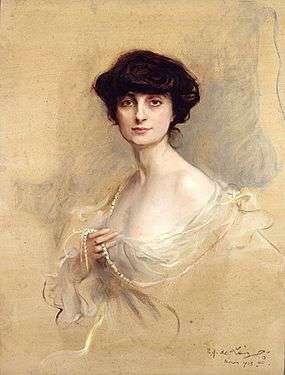Anna de Noailles
| Anna de Noailles | |
|---|---|
|
Photograph of Anna, Comtesse de Noailles (1922) | |
| Born |
15 November 1876 Paris |
| Died |
30 April 1933 (aged 56) Paris |
| Occupation | Novelist, poet |
| Language | French |
| Notable awards | Commander of the Legion of Honor |
Anna, Comtesse Mathieu de Noailles (15 November 1876 – 30 April 1933) was a Romanian-French writer.
Biography
Personal life
Born Princess Anna Elisabeth Bibesco-Bassaraba de Brancovan in Paris, she was a descendant of the Bibescu and Craioveşti families of Romanian boyars. Her father was Prince Grégoire Bibesco-Bassaraba, a son of Wallachian Prince Gheorghe Bibesco and Zoe Mavrocordato-Bassaraba de Brancovan. Her Greek mother was the former Ralouka (Rachel) Mussurus, a musician, to whom the Polish composer Ignacy Paderewski dedicated several of his compositions. Via her mother, Anna de Noailles is a great-great-granddaughter of Sophronius of Vratsa, one of the leading figures of the Bulgarian National Revival, through his grandson Stefan Bogoridi, caimacam of Moldavia.[1]
In 1897 she married Mathieu Fernand Frédéric Pascal de Noailles (1873–1942), the fourth son of the 7th Duke de Noailles. The couple soon became the toast of Parisian high society. They had one child, a son, Count Anne-Jules de Noailles (1900–1979).
Career
Anna de Noailles wrote three novels, an autobiography, and many collections of poetry. She had friendly relations with the intellectual, literary and artistic elite of the day including Marcel Proust, Francis Jammes, Colette, André Gide, Frédéric Mistral, Robert de Montesquiou-Fezensac, Paul Valéry, Jean Cocteau, Pierre Loti, Paul Hervieu, and Max Jacob.
She died in 1933 in Paris, aged 56, and was interred in the Père Lachaise Cemetery. She was a cousin of Prince Antoine Bibesco and Princess Marthe Bibesco.
In fine art
So popular was Anna de Noailles that various notable artists of the day painted her portrait, including Antonio de la Gandara, Kees van Dongen, Jacques Émile Blanche, and the British portrait painter Philip de László. In 1906 her image was sculpted by Auguste Rodin; the clay model can be seen today in the Musée Rodin in Paris, and the finished marble bust is on display in New York's Metropolitan Museum.
-

Anna, Comtesse de Noailles,1913 by Philip de László
-

Anna, Comtesse de Noailles, 1914 by Jean-Louis Forain
-

Anna, Comtesse de Noailles, 1936 by James Vibert
Awards
Anna de Noailles was the first woman to become a Commander of the Legion of Honor, the first woman to be received in the Royal Belgian Academy of French Language and Literature, and she was honored with the "Grand Prix" of the Académie Française in 1921.[2]
Countess de Noailles served as a juror with Florence Meyer Blumenthal in awarding the Prix Blumenthal, a grant given between 1919-1954 to painters, sculptors, decorators, engravers, writers, and musicians.[3]
Writings
| French literature |
|---|
| by category |
| French literary history |
| French writers |
|
| Portals |
|
- Le Cœur innombrable (1901)
- L'Ombre des jours (1902)
- La Nouvelle Espérance (1903)
- Le Visage émerveillé (1904)
- La Domination (1905)
- Les Éblouissements (1907)
- Les Vivants et les Morts (1913)
- Les Forces éternelles (1920)
- Les Innocentes, ou La Sagesse des femmes (1923)
- Poème de l'amour (1924)
- L'Honneur de souffrir (1927)
- Exactitudes, Paris (1930)
- Le Livre de ma vie (1932)
- Derniers Vers et Poèmes d'enfance (1934)
References
- ↑ Габровска, Людмила (23 October 2004). "Праправнучка на Софроний станала френска графиня (A great-great-granddaughter of Sophronius became a French countess)". Новинар (in Bulgarian). Новинар медиа EАД. Retrieved 23 September 2012.
- ↑ Catherine Perry, Sensual Deviations and Verbal Abuse: Anna de Noailles in the Critic’s Eye, in Diana Holmes and Carrie Tarr, Eds., A ‘Belle Epoque’? Women in French Society and Culture 1890-1914. Oxford and New York: Berghahn Books, 2006, p.239.
- ↑ "Florence Meyer Blumenthal". Jewish Women's Archive, Michele Siegel.
External links
| Wikimedia Commons has media related to Anna de Noailles. |
| Wikisource has original works written by or about: Anna de Noailles |
- Website on Anna de Noailles, in both English and French
- Anna de Noailles' Blog, in English
- A Swiss blog on Anna de Noailles, in French
- The Anna de Noailles Circle in France
- Catalog of the Bibliothèque Nationale de France from which it is now possible to download Anna de Noailles' works for free
- Works by Anna Elisabeth de Brancovan, comtesse de Noailles at Project Gutenberg
- Poems by Anna de Noailles
- The Anna de Noailles french school in Bucharest, Romania
